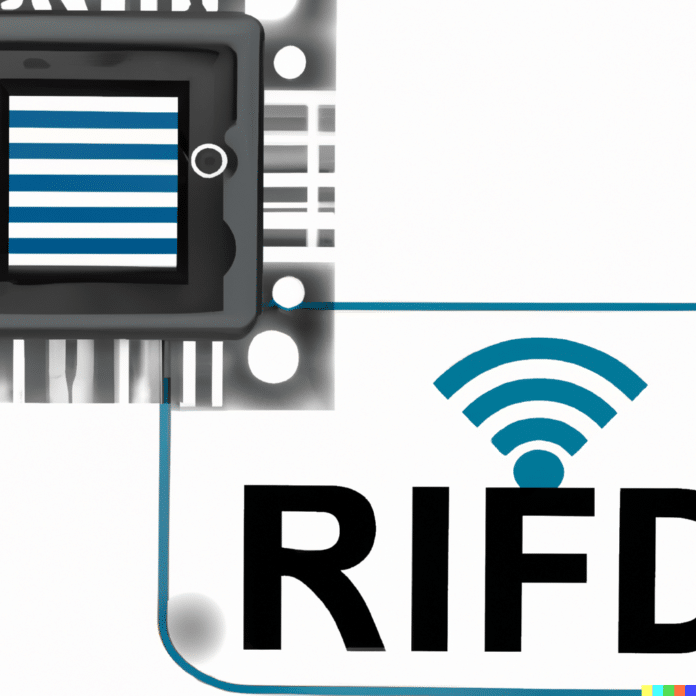What is RFID
RFID stands for Radio-Frequency Identification, it is a technology used for identifying and tracking objects wirelessly using radio waves. An RFID system consists of a reader, an antenna, and a tag (with a microchip and antenna) attached to the object to be tracked. The reader sends a radio frequency signal to the tag, which response with its unique identifier and other information stored in the chip. RFID is widely used in supply chain management, retail, and security applications.
The integration of RFID technology and Artificial Intelligence (AI) is expected to have a significant impact on various industries in 2023 and beyond. Some of the ways in which RFID and AI are expected to work together are:
- Predictive maintenance: RFID-enabled sensors can provide real-time data on the condition and performance of assets, which can be analyzed using AI algorithms to predict potential maintenance issues and optimize preventative maintenance schedules.
- Inventory optimization: AI algorithms can analyze RFID data to optimize inventory levels, reduce waste, and increase efficiency.
- Supply chain optimization: RFID and AI can be used to improve supply chain visibility and efficiency by providing real-time tracking of goods and reducing manual processes.
- Smart manufacturing: RFID and AI can be used to optimize production processes and reduce downtime, leading to increased efficiency and cost savings.
- Customer experience: AI algorithms can analyze RFID data to personalize the customer experience, such as providing product recommendations or optimizing the layout of a retail store.
Overall, the integration of RFID technology and AI has the potential to transform the way organizations operate and make data-driven decisions, leading to increased efficiency and cost savings.
The importance of RFID technology
The importance of RFID technology can be summarized in the following ways:
- Increased efficiency and accuracy: RFID can provide real-time data on the location and movement of assets, enabling organizations to streamline their operations and make informed decisions.
- Improved inventory management: RFID helps organizations to keep track of inventory levels in real time, reducing the risk of stockouts and overstocking.
- Better security: RFID technology can be used for security and access control, such as tracking individuals or assets within a restricted area.
- Enhanced customer experience: RFID can be used to improve the customer experience by providing instant access to product information, enabling customers to make informed purchasing decisions.
- Cost savings: By reducing manual processes and increasing efficiency, RFID can result in significant cost savings for organizations.
Overall, RFID technology offers a range of benefits that can help organizations improve their operations, increase efficiency, and drive business value.
Here is a simple example of how to read data from an RFID reader and store it in a PHP application:
<?php
// Connect to the RFID reader
$reader = new RFIDReader();
$reader->connect();
// Read the data from the RFID tag
$data = $reader->read();
// Store the data in the database
$db = new Database();
$db->connect();
$db->storeData($data);
// Disconnect from the RFID reader
$reader->disconnect();
?>
Advantages of RFID technology are:
- Real-time tracking: RFID enables organizations to track the movement of assets and inventory in real time, providing greater visibility and control over operations.
- Increased efficiency: RFID reduces manual processes and increases automation, leading to increased efficiency and cost savings.
- Improved accuracy: RFID eliminates the need for manual data entry, reducing the risk of errors and increasing accuracy.
- Enhanced security: RFID can be used for access control and security applications, helping to prevent theft and unauthorized access.
- Contactless technology: RFID enables contactless data transfer between the reader and the tag, reducing the risk of infection transmission and minimizing damage to the tag.
- Increased durability: RFID tags are small, durable, and can withstand harsh environments, making them suitable for use in a wide range of applications.
- Remote tracking: RFID allows for remote tracking of assets and inventory, even when they are not within line of sight.
- Cost-effective: RFID systems have become increasingly cost-effective, making them accessible to a wide range of organizations, regardless of size or industry.
Overall, RFID technology offers a range of benefits that can help organizations improve their operations, increase efficiency, and drive business value.
Disadvantages of RFID technology are:
- High upfront costs: RFID systems can be expensive to implement, especially for large-scale deployments.
- Technical complexity: RFID technology can be complex, requiring specialized expertise to install and maintain.
- Interference: RFID systems can be subject to interference from other electronic devices, leading to errors or decreased performance.
- Limited range: RFID systems have a limited range, requiring the tag to be close to the reader in order for data to be transmitted.
- Privacy concerns: RFID technology can be used to track the location and movements of individuals, raising concerns about privacy and security.
- Limited tag lifespan: RFID tags have a limited lifespan, requiring replacement over time.
- Tag readability: RFID tags can be difficult to read if they are covered by other materials, such as metal or water, reducing the accuracy of the data collected.
While RFID technology offers many benefits, it also has some limitations and challenges that organizations need to consider when implementing RFID systems.
Uses of RFID (Radio Frequency Identification) technology
- Supply chain management: RFID can be used to track the movement of goods throughout the supply chain, providing real-time visibility and reducing the risk of loss or theft.
- Inventory management: RFID can be used to automatically track inventory levels, reducing the risk of stockouts and overstocking.
- Asset tracking: RFID can be used to track the location and movement of assets, such as vehicles, equipment, and machinery.
- Retail: RFID can be used in retail to manage inventory levels, improve product availability, and enhance the customer experience.
- Healthcare: RFID can be used in healthcare to track patients, equipment, and medical supplies, improving patient safety and reducing the risk of errors.
- Logistics: RFID can be used in logistics to track the movement of packages and shipments, improving delivery times and reducing the risk of loss or damage.
- Agriculture: RFID can be used in agriculture to track the movement of livestock, crops, and other products, improving efficiency and reducing waste.
- Security: RFID can be used for access control and security applications, helping to prevent theft and unauthorized access.
Overall, RFID technology has a wide range of applications and can be used to improve efficiency, reduce costs, and drive business value in many industries.
Frequently asked questions (FAQ’s) about RFID technology:
What is RFID?
RFID stands for Radio Frequency Identification, a technology used for wireless communication between a reader and a tag attached to an object. The reader sends a signal to the tag, which response with information stored in the tag’s memory.
How does RFID work?
RFID systems consist of a reader, a tag, and an antenna. The reader sends a radio frequency signal to the antenna, which powers the tag and sends back data stored in the tag’s memory. The reader receives the data and sends it to a computer system for processing.
What are the different types of RFID tags?
There are two main types of RFID tags: passive and active. Passive tags are powered by the reader’s signal and have a limited range, while active tags have their own power source and can communicate over a greater distance.
What are the benefits of RFID technology?
RFID technology offers real-time tracking, increased efficiency, improved accuracy, enhanced security, and contactless technology, among other benefits.
What are the limitations of RFID technology?
Some of the limitations of RFID technology include high upfront costs, technical complexity, interference, limited range, privacy concerns, limited tag lifespan, and tag readability.
What are the applications of RFID technology?
RFID technology has a wide range of applications in various industries, including supply chain management, inventory management, asset tracking, retail, healthcare, logistics, agriculture, and security.
Conclusion
RFID (Radio Frequency Identification) technology is a wireless communication technology that has gained widespread adoption in various industries. RFID technology provides real-time tracking and improved efficiency, accuracy, and security compared to traditional identification methods. RFID tags can be passive or active and have a wide range of applications in industries such as supply chain management, inventory management, retail, healthcare, and security, among others. While RFID technology has many benefits, there are also some limitations, such as high upfront costs, technical complexity, and privacy concerns. Overall, RFID technology continues to play an important role in improving processes and driving business value in many industries.











